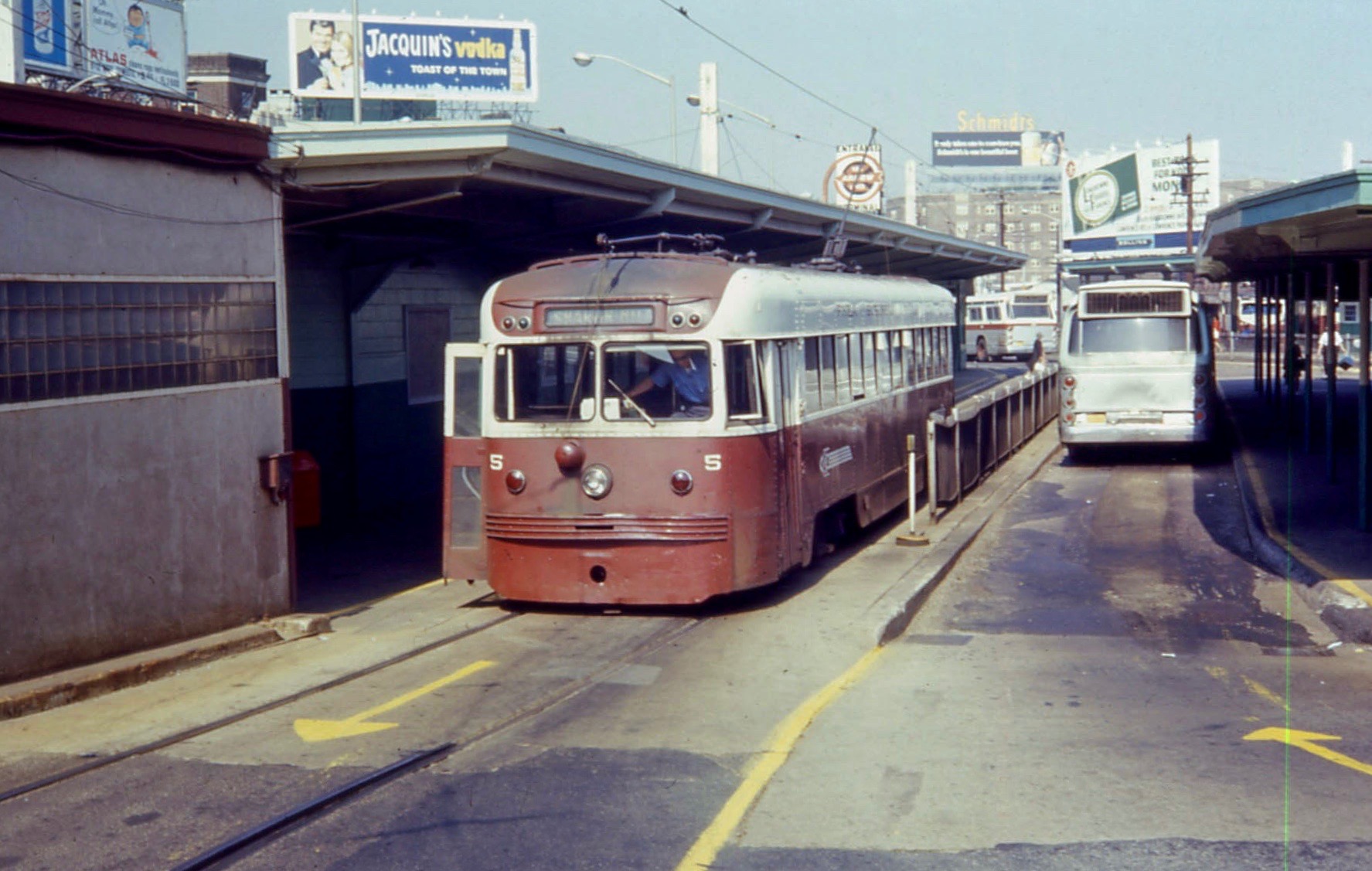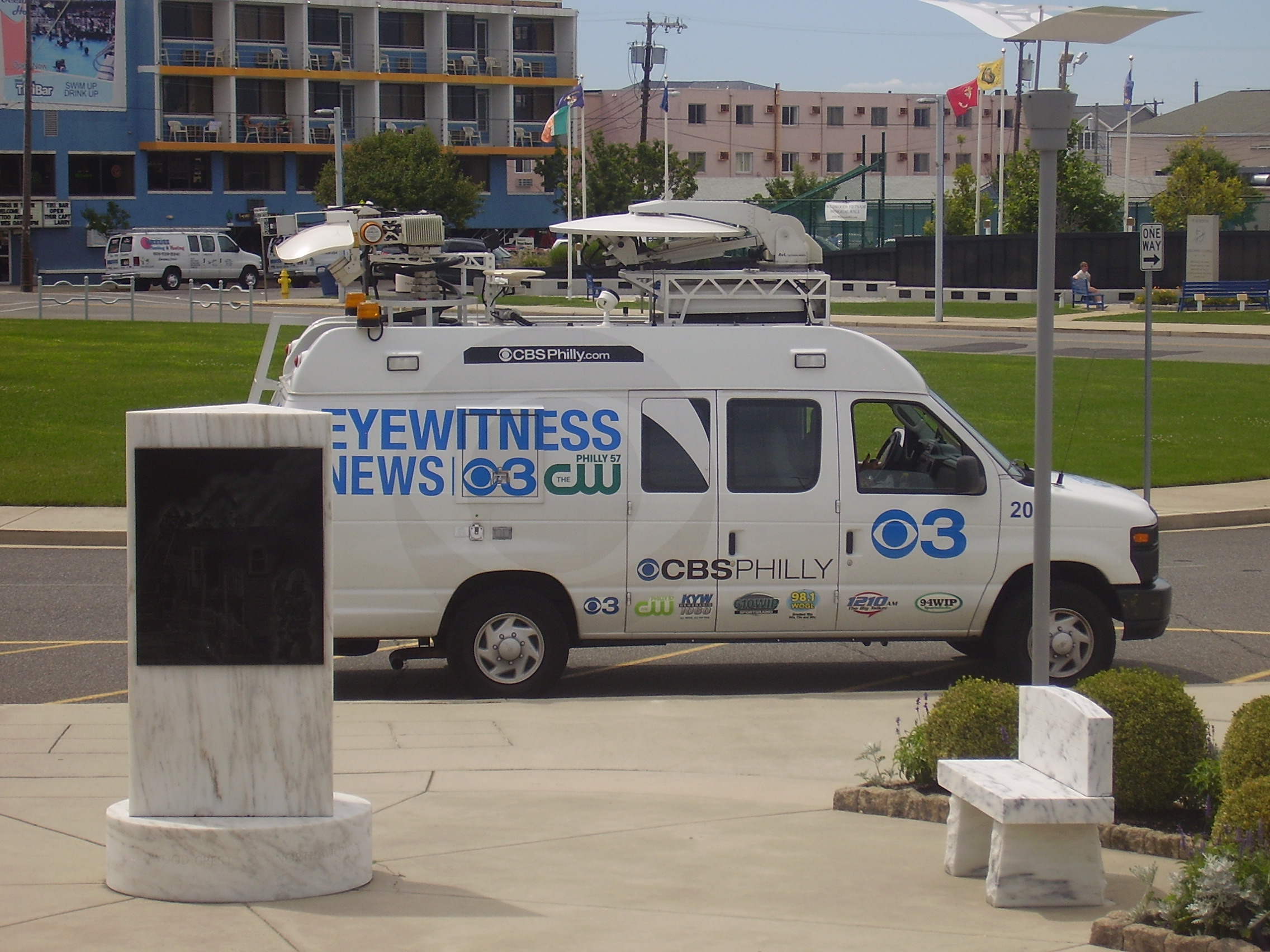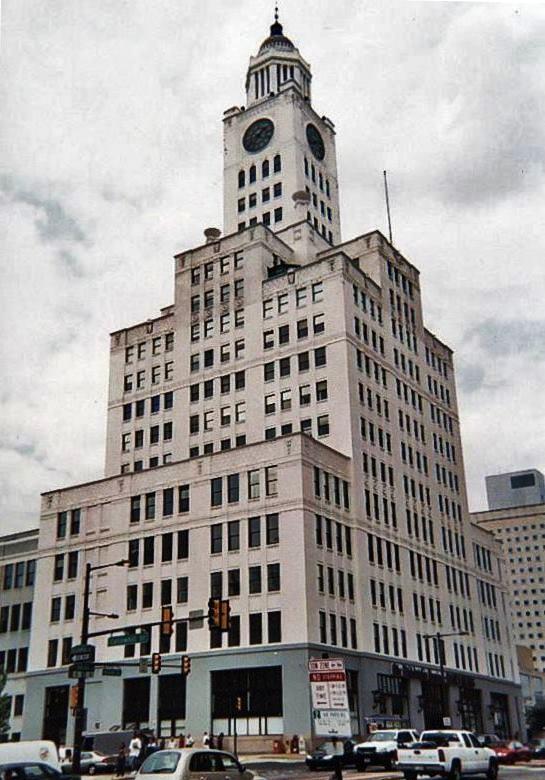|
69th Street Terminal
The 69th Street Transportation Center is a SEPTA terminal in the Terminal Square section of Upper Darby, Pennsylvania, just west of the city limits of Philadelphia. The terminal serves the Market–Frankford Line, Norristown High Speed Line, and the Media–Sharon Hill Line trolleys, and multiple bus routes. It is located at the end of 69th Street, a major retail corridor in Upper Darby, across Market Street ( Route 3) from the Tower Theater. Until 2011, the station was primarily known as 69th Street Terminal. 69th Street is the second busiest transfer point in the SEPTA system (after 15th Street/ City Hall station) serving 35,000 passengers every weekday. It is also the only SEPTA facility to serve both City Transit and Suburban Transit routes. History 69th Street is one of the original Market Street Elevated stations built by the Philadelphia Rapid Transit Company; the line opened for service on March 4, 1907 between here and stations. Shortly after on May 22 of the same yea ... [...More Info...] [...Related Items...] OR: [Wikipedia] [Google] [Baidu] |
Market Street (Philadelphia)
Market Street, originally known as High Street, is a major east–west street in Philadelphia. The street is signed as Pennsylvania Route 3 between 38th Street (U.S. Route 13) and 15th Street ( PA 611). A short portion of the road continues west from Cobbs Creek Parkway (63rd Street) to Delaware County, adjacent to Philadelphia. ‘High Street’ was the familiar name of the principal street in nearly every English town at the time Philadelphia was founded. But if Philadelphia was indebted to England for the name of High Street, nearly every American town is, in turn, indebted to Philadelphia for its Market Street. Long before the city was laid out or settled, Philadelphia's founder, William Penn, had planned that markets would be held regularly on the wide High Street. The city's first market stalls were situated in the center of the thoroughfare starting at Front Street and proceeding west eventually to 8th Street. The stalls soon became covered and were not taken down as pla ... [...More Info...] [...Related Items...] OR: [Wikipedia] [Google] [Baidu] |
City Hall Station (SEPTA)
City Hall station is a SEPTA subway station in Philadelphia. Located in Center City underneath City Hall, it serves the Broad Street Line. It is the busiest station on the line, serving 57,000 passengers daily. City Hall station is served by local, express, and special "Sport Express" trains. Entrances are located on the east and west sides of City Hall, as well as in the central courtyard. Station layout Interchanges A free interchange is available between all of the subway lines here, including the 15th Street stop for the Market–Frankford Line and all SEPTA subway–surface trolley routes (routes 10, 11, 13, 34 & 36). The station is connected to the Center City Concourse, a system of underground passageways, which connects to Suburban Station, thus providing access to SEPTA Regional Rail. City Hall Station is also connected to the Broad Street Line's Walnut–Locust Station, which in turn is connected to PATCO Speedline's 12–13th & Locust Station and 15� ... [...More Info...] [...Related Items...] OR: [Wikipedia] [Google] [Baidu] |
KYW-TV
KYW-TV (channel 3) is a television station in Philadelphia, Pennsylvania, United States, airing programming from the CBS network. It is owned and operated by the network's CBS News and Stations division alongside CW affiliate WPSG (channel 57). Both stations share studios on Hamilton Street north of Center City, Philadelphia, while KYW-TV's transmitter is located in the city's Roxborough section. KYW-TV, along with sister station KDKA-TV in Pittsburgh, are the only CBS-affiliated stations east of the Mississippi River with "K" call signs. History As WPTZ (1932–1953) The channel 3 facility in Philadelphia is Pennsylvania's oldest television station. It began in 1932 as W3XE, an experimental station owned by Philadelphia's Philco Corporation, at the time and for some decades to come one of the world's largest manufacturers of radio and television sets. Philco engineers created much of the station's equipment, including cameras. When the station began operations as W3XE, it w ... [...More Info...] [...Related Items...] OR: [Wikipedia] [Google] [Baidu] |
The Philadelphia Inquirer
''The Philadelphia Inquirer'' is a daily newspaper headquartered in Philadelphia, Pennsylvania. The newspaper's circulation is the largest in both the U.S. state of Pennsylvania and the Delaware Valley metropolitan region of Southeastern Pennsylvania, South Jersey, Delaware, and the northern Eastern Shore of Maryland, and the 17th largest in the United States as of 2017. Founded on June 1, 1829 as ''The Pennsylvania Inquirer'', the newspaper is the third longest continuously operating daily newspaper in the nation. It has won 20 Pulitzer Prizes . ''The Inquirer'' first became a major newspaper during the American Civil War. The paper's circulation dropped after the Civil War's conclusion but then rose again by the end of the 19th century. Originally supportive of the Democratic Party, ''The Inquirers political orientation eventually shifted toward the Whig Party and then the Republican Party before officially becoming politically independent in the middle of the 20th cen ... [...More Info...] [...Related Items...] OR: [Wikipedia] [Google] [Baidu] |
PST Brilliner 5 At 69th Street Terminal In 1968
PST may refer to: Time zones * Pacific Standard Time, UTC−08:00 * Pakistan Standard Time (PKT), UTC+05:00 * Philippine Standard Time, UTC+08:00 Science and technology * Lead scandium tantalate, a ceramic material * Post-stall technology, aircraft control system * Computer program structure tree * Pocket set theory * Planar separator theorem in graph theory * ''Puccinia striiformis'' f.sp. ''tritici'', or Wheat yellow rust *PstLM, short-term light flicker metric * Penoscrotal transposition Economics * Provincial Sales Tax, a sales tax in most Canadian provinces * The Prebisch–Singer thesis or Prebisch–Singer hypothesis Places * Trail of Remembrance and Comradeship ( sl, Pot spominov in tovarištva, links=no), a walkway in Ljubljana, Slovenia * Poznań Fast Tram ( pl, Poznański Szybki Tramwaj, links=no), Poland * Prestonpans railway station, East Lothian, Scotland, station code Other uses * Personal Storage Table, a file format used in Microsoft applications ... [...More Info...] [...Related Items...] OR: [Wikipedia] [Google] [Baidu] |
Red Arrow Lines
SEPTA Routes 101 and 102, also known as the Media–Sharon Hill Line, are light rail lines operated by the Suburban Transit Division of the Southeastern Pennsylvania Transportation Authority, serving portions of Delaware County. The routes' eastern terminus is 69th Street Transportation Center in Upper Darby, Pennsylvania. Route 101 runs to Media, while Route 102 goes to Sharon Hill. Altogether, the two lines operate on approximately of route. The lines were formerly interurbans. Along with the Norristown High Speed Line, formerly the Philadelphia and Western Railroad, the routes are the remaining lines of the Red Arrow Lines Trolley System once operated by the Philadelphia Suburban Transportation Company (successor to the Philadelphia and West Chester Traction Company); some local residents still call them "Red Arrow". This route uses 29 Kawasaki Heavy Industries Rolling Stock Company Type K LRV cars similar to those used on the SEPTA Subway–Surface Trolley Lines. Howeve ... [...More Info...] [...Related Items...] OR: [Wikipedia] [Google] [Baidu] |
Philadelphia Suburban Transportation Company
SEPTA Routes 101 and 102, also known as the Media–Sharon Hill Line, are light rail lines operated by the Suburban Transit Division of the Southeastern Pennsylvania Transportation Authority, serving portions of Delaware County. The routes' eastern terminus is 69th Street Transportation Center in Upper Darby, Pennsylvania. Route 101 runs to Media, while Route 102 goes to Sharon Hill. Altogether, the two lines operate on approximately of route. The lines were formerly interurbans. Along with the Norristown High Speed Line, formerly the Philadelphia and Western Railroad, the routes are the remaining lines of the Red Arrow Lines Trolley System once operated by the Philadelphia Suburban Transportation Company (successor to the Philadelphia and West Chester Traction Company); some local residents still call them "Red Arrow". This route uses 29 Kawasaki Heavy Industries Rolling Stock Company Type K LRV cars similar to those used on the SEPTA Subway–Surface Trolley Lines. Howeve ... [...More Info...] [...Related Items...] OR: [Wikipedia] [Google] [Baidu] |
Philadelphia And West Chester Traction Company
Philadelphia, often called Philly, is the largest city in the Commonwealth of Pennsylvania, the sixth-largest city in the U.S., the second-largest city in both the Northeast megalopolis and Mid-Atlantic regions after New York City. Since 1854, the city has been coextensive with Philadelphia County, the most populous county in Pennsylvania and the urban core of the Delaware Valley, the nation's seventh-largest and one of world's largest metropolitan regions, with 6.245 million residents . The city's population at the 2020 census was 1,603,797, and over 56 million people live within of Philadelphia. Philadelphia was founded in 1682 by William Penn, an English Quaker. The city served as capital of the Pennsylvania Colony during the British colonial era and went on to play a historic and vital role as the central meeting place for the nation's founding fathers whose plans and actions in Philadelphia ultimately inspired the American Revolution and the nation's independenc ... [...More Info...] [...Related Items...] OR: [Wikipedia] [Google] [Baidu] |
Transit-oriented Development
In urban planning, transit-oriented development (TOD) is a type of urban development that maximizes the amount of residential, business and leisure space within walking distance of public transport. It promotes a symbiotic relationship between dense, compact urban form and public transport use. In doing so, TOD aims to increase public transport ridership by reducing the use of private cars and by promoting sustainable urban growth. TOD typically includes a central transit stop (such as a train station, or light rail or bus stop) surrounded by a high-density mixed-use area, with lower-density areas spreading out from this center. TOD is also typically designed to be more walkable than other built-up areas, by using smaller block sizes and reducing the land area dedicated to automobiles. The densest areas of TOD are normally located within a radius of to mile (400 to 800 m) around the central transit stop, as this is considered to be an appropriate scale for pedestrians, thu ... [...More Info...] [...Related Items...] OR: [Wikipedia] [Google] [Baidu] |
Norristown Transportation Center
Norristown Transportation Center is a two-level multimodal public transportation regional hub located in Norristown, Pennsylvania, USA, operated by SEPTA. It opened in 1989 to replace the older Norristown High Speed Line (Route 100) terminus one block away at Main and Swede Streets, and integrated the former Reading Company DeKalb Street Norristown railroad station (built 1933) into its structure. A plaque embedded in the sidewalk (between the bus lane and Lafayette Street) commemorates the location of one of the columns of the dismantled segment of the Philadelphia and Western Railroad (P&W) trestle. Regional rail service The Norristown Transportation Center is a stop on the Manayunk/Norristown Regional Rail Line which offers service to Center City Philadelphia via Conshohocken and Manayunk. In FY 2017, the regional rail service at Norristown Transportation Center had a weekday average of 856 boardings and 781 alightings. Norristown High Speed Line Norristown Transpor ... [...More Info...] [...Related Items...] OR: [Wikipedia] [Google] [Baidu] |
Electric Multiple Unit
An electric multiple unit or EMU is a multiple-unit train consisting of self-propelled carriages using electricity as the motive power. An EMU requires no separate locomotive, as electric traction motors are incorporated within one or a number of the carriages. An EMU is usually formed of two or more semi-permanently coupled carriages, but electrically powered single-unit railcars are also generally classed as EMUs. The great majority of EMUs are passenger trains, but versions also exist for carrying mail. EMUs are popular on commuter and suburban rail networks around the world due to their fast acceleration and pollution-free operation. Being quieter than diesel multiple units (DMUs) and locomotive-hauled trains, EMUs can operate later at night and more frequently without disturbing nearby residents. In addition, tunnel design for EMU trains is simpler as no provision is needed for exhausting fumes, although retrofitting existing limited-clearance tunnels to accommodate the ... [...More Info...] [...Related Items...] OR: [Wikipedia] [Google] [Baidu] |
Bullet (interurban)
The Bullet was a streamliner electric multiple-unit passenger car produced by the J. G. Brill Company in Philadelphia for the Philadelphia and Western Railroad (P&W) in 1931, and then similar, somewhat smaller single-unit, single-end versions were built for the Fonda, Johnstown and Gloversville Railroad in 1932. Few were sold because of the Great Depression and the public transport decline in the 1930s. However, some of the P&W cars ran for almost 60 years while later being under SEPTA. The first American railroad car in a wind tunnel The Bullets were a result of a broad research program. This program was led by Philadelphia and Western's vice-chairman W. L. Butler, who had been largely responsible for development of the Cincinnati and Lake Erie Railroad's Red Devil car design, in collaboration with the J. G. Brill Company. Unlike the Red Devils, the Bullets had all-aluminum bodies. Their design was improved over earlier styles of railcars after a lot of wind tunnel research – ... [...More Info...] [...Related Items...] OR: [Wikipedia] [Google] [Baidu] |

.jpg)



